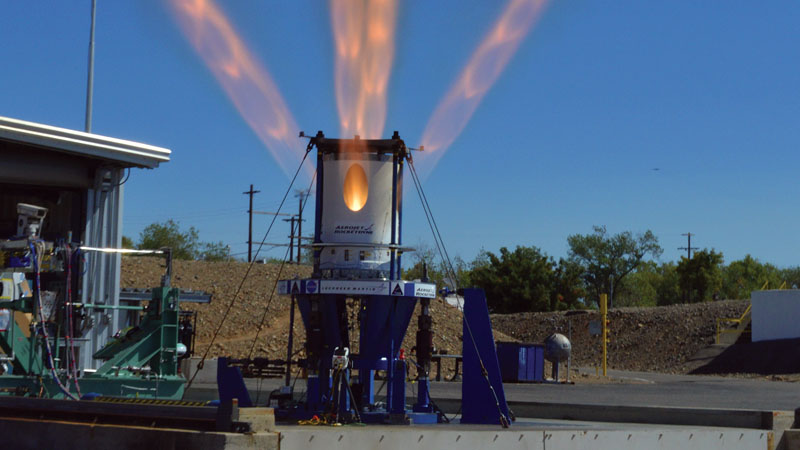Stay Up to Date
Submit your email address to receive the latest industry and Aerospace America news.
Work to include a motor for module’s first astronaut mission
Now that an Orion jettison motor has performed as planned in the third ground test of the motors, Aerojet Rocketdyne plans to start work on six more, including one NASA intends to install atop a Space Launch System rocket for Orion’s first astronaut flight.
Each jettison motor will be a critical component of the Launch Abort System, a stack of motors and an aeroshell that would whisk a crew away from an exploding or fizzing SLS launch vehicle. In an emergency, the abort motor would jolt the Orion crew capsule and its aeroshell off the failing SLS. An attitude control motor would then steer the assembly toward a gentle parachute landing once the jettison motor separates the crew capsule from the aeroshell.
On a nominal launch, the jettison motor will ignite in space to pull the entire abort system away from Orion. That step is necessary to clear the way for the parachutes, which are stored directly under the Launch Abort System, to be deployed when Orion splashes down in the ocean on its return.
Engineers faced an interesting challenge because of the motor’s position above Orion.
“We had to get the exhaust out and around the capsule because this motor fires just above the crew module,” said Don Mahr, Aerojet Rocketdyne’s jettison motor program manager. This was done by channeling the exhaust through multiple nozzles.
“The exhaust plumes go in four different directions to help us avoid impinging our hot gas on the crew module.”
One of the four jettison motor exhaust plumes is slightly smaller than the other three. That design is intended to push the entire Launch Abort System to the side and move it out of the way of the crew capsule in flight.
For the Aug. 31 static test, Aerojet Rocketdyne engineers mounted the jettison motor upside down on the test stand to make it easier to gather extensive data on the jettison motor’s performance.
The motor was the first of seven the firm is building for NASA and Orion prime contractor, Lockheed Martin, under its current contract. Two of Aerojet Rocketdyne’s jettison motors flew on Orion’s Pad Abort test in 2010 and Orion’s uncrewed test flight in 2014.
Next year, Aerojet Rocketdyne plans to build the first flight versions of jettison motors. One will ride on the first Space Launch System launch with an Orion module, a crewless flight called Exploration Mission-1. Others will ignite in NASA’s Ascent Abort test, in which the Launch Abort System will attempt to demonstrate it can hurtle an Orion mockup vehicle away from a Peacekeeper missile standing in for an SLS rocket.
In addition, Aerojet Rocketdyne intends to build three jettison motors for tests to qualify the motor design for flight, before building the jettison motor for Exploration Mission-2, NASA’s planned launch in the early 2020s to send astronauts into orbit on an Orion and SLS for the first time. ★
About Debra Werner
A longtime contributor to Aerospace America, Debra is also a correspondent for Space News on the West Coast of the United States.
Related Posts
Stay Up to Date
Submit your email address to receive the latest industry and Aerospace America news.




